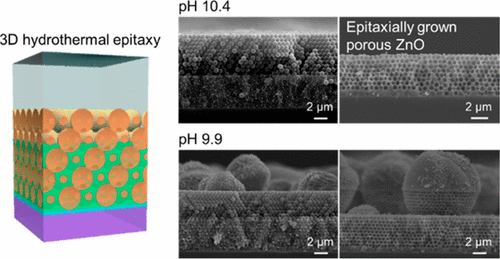当前位置:
X-MOL 学术
›
Chem. Mater.
›
论文详情
Our official English website, www.x-mol.net, welcomes your feedback! (Note: you will need to create a separate account there.)
Low-Temperature Hydrothermal Synthesis of Colloidal Crystal Templated Nanostructured Single-Crystalline ZnO
Chemistry of Materials ( IF 8.6 ) Pub Date : 2017-11-09 00:00:00 , DOI: 10.1021/acs.chemmater.7b03466 Masao Miyake 1, 2 , Makoto Suginohara 1 , Naoto Narahara 1 , Tetsuji Hirato 1 , Paul V. Braun 2
Chemistry of Materials ( IF 8.6 ) Pub Date : 2017-11-09 00:00:00 , DOI: 10.1021/acs.chemmater.7b03466 Masao Miyake 1, 2 , Makoto Suginohara 1 , Naoto Narahara 1 , Tetsuji Hirato 1 , Paul V. Braun 2
Affiliation

|
Single crystal semiconductors almost always exhibit better optoelectrical properties than their polycrystalline or amorphous counterparts. While three-dimensionally (3D) nanostructured semiconductor devices have been proposed for numerous applications, in the vast majority of reports, the semiconductor is polycrystalline or amorphous, greatly reducing the potential for advanced properties. While technologies for 3D structuring of semiconductors via use of a 3D template have advanced significantly, approaches for epitaxially growing nanostructured single crystal semiconductors within a template remain limited. Here, we demonstrate the epitaxial growth of 3D-structured ZnO through colloidal templates formed from 225 and 600 nm diameter colloidal particles via a low-temperature (∼80 °C) hydrothermal process using a flow reactor. The effects of the pH of the reaction solution as well as the additive used on the 3D epitaxy process are investigated. The optical and electrical properties of the epitaxially grown nanostructured ZnO are probed by reflectance, photoluminescence, and Hall effect measurements. It is found that the epitaxially grown nanostructured ZnO generally exhibits properties superior to those of polycrystalline ZnO. The demonstrated hydrothermal epitaxy process should be applicable to other chemical solution-based deposition techniques and help extend the range of materials that can be grown into a 3D nanostructured single-crystalline form.
中文翻译:

低温水热法合成胶体晶体模板纳米结构单晶ZnO
单晶半导体几乎总是比其多晶或非晶态半导体具有更好的光电性能。尽管已经提出了三维(3D)纳米结构的半导体器件用于众多应用,但在绝大多数报告中,半导体都是多晶或非晶态的,大大降低了先进性能的潜力。尽管通过使用3D模板进行半导体3D结构化的技术已经取得了显着进步,但是在模板中外延生长纳米结构单晶半导体的方法仍然受到限制。在这里,我们通过使用流动反应器的低温(〜80°C)水热工艺,通过由225和600 nm直径的胶体粒子形成的胶体模板,证明了3D结构ZnO的外延生长。研究了反应溶液的pH值以及在3D外延工艺中使用的添加剂的影响。通过反射率,光致发光和霍尔效应测量来探测外延生长的纳米结构ZnO的光学和电学性质。发现外延生长的纳米结构ZnO通常表现出优于多晶ZnO的性能。证明的热液外延工艺应适用于其他基于化学溶液的沉积技术,并有助于扩展可以生长为3D纳米结构单晶形式的材料的范围。光致发光和霍尔效应测量。发现外延生长的纳米结构ZnO通常表现出优于多晶ZnO的性能。证明的热液外延工艺应适用于其他基于化学溶液的沉积技术,并有助于扩展可以生长为3D纳米结构单晶形式的材料的范围。光致发光和霍尔效应测量。发现外延生长的纳米结构ZnO通常表现出优于多晶ZnO的性能。证明的热液外延工艺应适用于其他基于化学溶液的沉积技术,并有助于扩展可以生长为3D纳米结构单晶形式的材料的范围。
更新日期:2017-11-09
中文翻译:

低温水热法合成胶体晶体模板纳米结构单晶ZnO
单晶半导体几乎总是比其多晶或非晶态半导体具有更好的光电性能。尽管已经提出了三维(3D)纳米结构的半导体器件用于众多应用,但在绝大多数报告中,半导体都是多晶或非晶态的,大大降低了先进性能的潜力。尽管通过使用3D模板进行半导体3D结构化的技术已经取得了显着进步,但是在模板中外延生长纳米结构单晶半导体的方法仍然受到限制。在这里,我们通过使用流动反应器的低温(〜80°C)水热工艺,通过由225和600 nm直径的胶体粒子形成的胶体模板,证明了3D结构ZnO的外延生长。研究了反应溶液的pH值以及在3D外延工艺中使用的添加剂的影响。通过反射率,光致发光和霍尔效应测量来探测外延生长的纳米结构ZnO的光学和电学性质。发现外延生长的纳米结构ZnO通常表现出优于多晶ZnO的性能。证明的热液外延工艺应适用于其他基于化学溶液的沉积技术,并有助于扩展可以生长为3D纳米结构单晶形式的材料的范围。光致发光和霍尔效应测量。发现外延生长的纳米结构ZnO通常表现出优于多晶ZnO的性能。证明的热液外延工艺应适用于其他基于化学溶液的沉积技术,并有助于扩展可以生长为3D纳米结构单晶形式的材料的范围。光致发光和霍尔效应测量。发现外延生长的纳米结构ZnO通常表现出优于多晶ZnO的性能。证明的热液外延工艺应适用于其他基于化学溶液的沉积技术,并有助于扩展可以生长为3D纳米结构单晶形式的材料的范围。



























 京公网安备 11010802027423号
京公网安备 11010802027423号